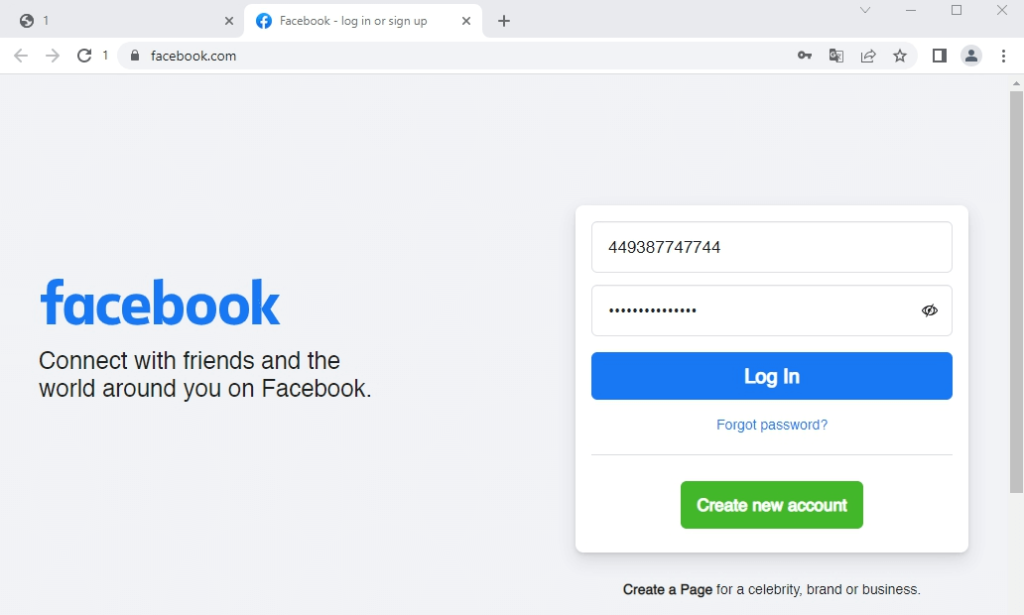Facebook Login: Facebook stands as a leading social media platform, connecting millions globally.
Ensuring secure and efficient access to your account is crucial for maintaining privacy and optimizing user experience, making it vital to understand the proper login procedures.
Preparing to Facebook Login
Logging into your Facebook account should be a seamless and secure experience. Before you begin, it’s crucial to ensure that your device is protected to prevent unauthorized access and safeguard your personal information. Here’s how you can prepare:
Ensuring Device Security Before Logging In
- Update Your Device: Ensure that your smartphone, tablet, or computer has the latest security updates and patches installed. This helps protect against vulnerabilities that could be exploited by hackers.
- Install Antivirus Software: Use reputable antivirus software, especially on computers, to prevent malware and viruses from compromising your login credentials.
- Use a Secure Network: Always log in using a secure Wi-Fi network. Avoid using public or unsecured Wi-Fi networks for logging into your account, as these can be prone to interception.
- Enable Firewall: If logging in from a computer, ensure that your firewall is enabled. This adds an extra layer of security against potential cyber threats.
- Check for Security Certificates: Before logging into Facebook, ensure the website’s security certificate is valid by looking for a padlock symbol in the browser’s address bar, indicating a secure connection.
Necessary Information and Credentials Needed for Logging In
- Email Address or Phone Number: You’ll need the email address or phone number associated with your Facebook account. This is essential for identifying your account during the login process.
- Password: Your Facebook password is crucial. Ensure it’s strong—use a mix of letters, numbers, and symbols to enhance security.
- Two-Factor Authentication (2FA) Codes: If you’ve enabled 2FA, have your mobile device ready to receive the authentication code through SMS or a dedicated authenticator app.
- Recovery Options: Keep access to your recovery email or phone number up to date. These can help you regain access to your account if you forget your password.
By taking these steps, you can ensure a safe and hassle-free login to your Facebook account, keeping your data secure while you stay connected with friends and family.
Step-by-Step Guide to Login to Facebook
Navigating the world of social media can be daunting, but logging into Facebook doesn’t have to be! Whether you prefer to use your web browser or the mobile app, this simple guide will get you online in no time.
For Web Users:
1. Open Your Browser: Start by launching your preferred web browser on your computer or laptop.

2. Visit the Website: Type facebook.com in the address bar and press Enter. This will take you directly to the Facebook homepage.
3. Enter Your Login Details: On the Facebook homepage, you’ll find the login fields at the top right corner. Enter your registered email address or phone number, followed by your password.
4. Log In: After entering your credentials, click the ‘Log In’ button. If your details are correct, you will be redirected to your Facebook feed.
For App Users:
1. Open the Facebook App: Locate the Facebook app on your mobile device and tap to open it.
2. Enter Your Credentials: When the app opens, you’ll see fields for entering your email or phone number and password. Fill these in with the details associated with your Facebook account.
3. Log In: Tap the ‘Log In’ button. If your details are accurate, you will be immediately taken to your news feed where you can catch up on the latest posts.
Importance of Reviewing Terms Before Agreeing:
Understanding the terms and conditions of any service is crucial, and Facebook is no exception. Here’s why you should review them carefully:
1. Privacy Protection: Learn how your data is collected, used, and protected. Facebook’s terms outline what information they track and how it is handled.
2. Usage Guidelines: Know what is acceptable on the platform to avoid any potential violations that could jeopardize your account.
3. Feature Limitations: Understanding the terms helps you know the extent of what Facebook offers and any limitations that might affect how you use the platform.
4. Legal Rights: Be aware of your legal rights and obligations under the agreement to better understand what recourse you have in potential disputes.
By being informed about these details, you can ensure a safer and more enjoyable experience on Facebook.
Troubleshooting Facebook Login Problems
Encountering issues while trying to log into Facebook can be frustrating. Here, we explore some common login problems and their solutions, as well as how to contact Facebook support if you need further assistance.
Common Login Problems and Solutions
- Forgotten Password: If you’ve forgotten your Facebook password, you can reset it by clicking on the “Forgotten password?” link on the login page. Follow the prompts to enter your email or phone number associated with your account, and Facebook will send you instructions to reset your password.
- Account Locked: Facebook may lock accounts deemed to be compromised or in violation of Facebook’s community standards. To regain access, follow the account recovery options which typically involve verifying your identity through a series of questions or by providing identification.
- Error Messages: If you see error messages such as “Invalid username or password,” double-check your credentials and try again. If the issue persists, consider resetting your password.
- Browser Issues: Sometimes, browser settings or outdated cache data can prevent you from logging in. Try clearing your browser’s cache and cookies, or log in from a different browser or device.
- Two-Factor Authentication Problems: If you’re having trouble with two-factor authentication, ensure you have access to the secondary verification method set up, such as your mobile device or authentication app. If you’ve lost access, you’ll need to follow the prompts for recovery on the login page.
Contacting Facebook Support for Login Issues
If the solutions above don’t resolve your login issues, you may need to contact Facebook support:
- Help Center: Visit Facebook’s Help Center, which provides answers to a wide range of common issues including login problems.
- Report a Login Issue: If you can’t find your problem in the Help Center, you can use the “Report a Login Issue” form to contact Facebook directly. Describe your issue in detail, including any error messages you have received, and submit the form.
- Support Inbox: If you have access to your account, check your Support Inbox. You can find it by clicking on “Settings” and then “Support Inbox”. Here, you can track the status of your reports and receive updates from Facebook.
By addressing these issues promptly and knowing how to contact support when needed, you can quickly resolve login problems and get back to connecting with friends and family on Facebook.
Enhancing Your Facebook Login Security
Ensuring the security of your Facebook account is crucial in protecting your personal information from unauthorized access. Here are essential strategies to enhance your login security:
Set Up Two-Factor Authentication (2FA)
Two-factor authentication adds an extra layer of security by requiring not only your password but also a second factor, usually a code sent to your phone, to access your account. Here’s how to enable it:
- Go to your Facebook Settings.
- Select ‘Security and Login’.
- Scroll down to ‘Two-Factor Authentication’.
- Click on ‘Edit’ and follow the prompts to set up 2FA.
Tips for Creating and Managing Strong Passwords
Strong passwords are your first defense against unauthorized access to your account. Consider these tips for robust passwords:
- Length and Complexity: Use at least 12 characters, mixing letters, numbers, and special symbols.
- Unpredictability: Avoid common words and phrases. Instead, consider using a passphrase or a combination of unrelated words and characters.
- Unique Passwords: Use a unique password for Facebook that isn’t shared with other sites.
- Password Managers: Consider using a password manager to generate and store your passwords securely.
Regular Security Checks and Updates
Regularly reviewing your security settings ensures your protections are current and effective. Here’s how to conduct a security checkup:
- Visit the ‘Security and Login’ settings on Facebook.
- Look for any unfamiliar locations or devices that have accessed your account and log them out.
- Update your password regularly, especially if you suspect it may have been compromised.
- Keep your recovery options (email and phone number) up to date to secure your account recovery process.
By following these guidelines, you can significantly enhance the security of your Facebook login, safeguarding your personal information against potential threats.
Advanced Facebook Features
Facebook has evolved from a simple social networking platform to a robust tool with numerous advanced features. These features enhance user interaction and security, making Facebook an indispensable tool for both personal and professional use.
Unique Facebook Features
- Facebook Marketplace: This e-commerce platform enables users to buy, sell, and trade items within their local community directly through Facebook, streamlining the buying and selling process.
- Facebook Watch: A video-on-demand service that offers users a wide array of content including original shows, sports events, and user-generated material.
- Facebook Live: Allows users to broadcast live videos to their friends or the public, providing real-time interaction with viewers through comments and reactions.
- Facebook Stories: Enables users to post photos or short videos that disappear after 24 hours, a feature that encourages more spontaneous and timely sharing.
- Facebook Groups: Offers the ability to create and manage communities around specific interests or causes, complete with dedicated news feeds, member vetting, and more.
- Facebook Events: A powerful tool for organizing gatherings, allowing users to create event pages, send invitations, manage RSVPs, and communicate with attendees.
Understanding and Managing Facebook’s Remembered Devices and Sessions
Facebook provides users with the ability to see and control where they’re logged in through the “Security and Login” settings. This feature helps enhance security by allowing users to:
- Review Remembered Devices: Users can see a list of devices where they have chosen to stay logged in. This makes it easier to manage multiple sessions and ensures that one can easily log out from forgotten sessions.
- Manage Active Sessions: Each device and location where the user is currently logged in is displayed, along with the option to log out remotely. This is particularly useful if a device is lost or if one forgets to log out from a public computer.
- Receive Alerts for Unrecognized Logins: Facebook can notify users if someone logs in from a device or browser that isn’t recognized, adding an extra layer of security.
By leveraging these features, users can maintain greater control over their Facebook account, ensuring a secure and personalized experience.
FAQs about Facebook Login
1. What is Facebook Login?
Facebook Login is a feature that allows users to access websites, applications, and services using their Facebook account details, eliminating the need for multiple usernames and passwords.
2. How do I set up Facebook Login?
To set up Facebook Login, go to the settings of the app or website you want to access, select ‘Log in with Facebook,’ and enter your Facebook credentials. Follow the prompts to authorize the connection to your Facebook account.
3. Is Facebook Login secure?
Yes, Facebook Login is designed with security in mind. It uses various security measures to protect your information, though it’s important to keep your Facebook account secure with a strong password and two-factor authentication.
4. What information does Facebook share when I use Facebook Login?
The information shared can vary depending on the website or app’s requirements but typically includes your name, profile picture, and email address. You can customize what additional information, if any, is shared through the Facebook settings panel.
5. Can I use Facebook Login on multiple devices?
Yes, you can use Facebook Login across multiple devices. Just log in to your Facebook account on any device, and you can use Facebook Login wherever it is supported.
6. What should I do if I encounter problems with Facebook Login?
If you encounter issues, ensure you are using the correct login details and that there are no restrictions on your Facebook account. You can also try resetting your password or contacting the support team of the app or website for further assistance.
7. How do I disconnect a service or app from my Facebook Login?
To disconnect a service or app, go to your Facebook settings, find the section on Apps and Websites, and you’ll see a list of apps connected to your account. From there, you can remove any you no longer want connected.
8. Can I still access my accounts if I deactivate my Facebook account?
Deactivating your Facebook account may prevent you from accessing services or apps using Facebook Login. It’s best to create separate logins for these services before deactivating your account.
Conclusion
In summary, logging into your Facebook account involves a few straightforward steps: starting with accessing the Facebook homepage or app, entering your email or phone number, followed by your password, and clicking ‘Log In’. If you encounter any issues, utilizing the password recovery tool is a reliable way to regain access.
It’s essential to maintain robust security practices to protect your Facebook account. Always use a strong, unique password and consider enabling two-factor authentication for an added layer of security. Staying vigilant and updating your security settings regularly can help safeguard your personal information against unauthorized access.
By following these steps and prioritizing your account’s security, you can enjoy a seamless and safe experience on Facebook.
References
For further exploration and validation of the details shared about Facebook login functionalities and the utilization of post links, the following reputable sources offer in-depth knowledge and technical guidance:
- Facebook for Developers Documentation – This official resource provides comprehensive guides and API references to help developers integrate and manage Facebook login capabilities. Visit the Facebook for Developers site.
- Stack Overflow – A vital community for developers, where one can find a myriad of discussions and solutions related to Facebook login issues and updates. Useful for troubleshooting and community support. Explore relevant discussions on Stack Overflow.
- OAuth 2.0 and OpenID Connect (OIDC) Protocols – Understanding these protocols can provide deeper insights into the security mechanisms behind Facebook login. Read more about OAuth 2.0 and OpenID Connect.
- Social Media Examiner – Offers practical tips and strategic advice for effectively using Facebook’s features, including login integrations, to enhance user engagement and security. Check out Social Media Examiner.
- TechCrunch – Stay updated with the latest news and developments about Facebook and its login features, which can be crucial for maintaining compatibility and enhancing user experiences. Visit TechCrunch.
These resources are essential for developers and content managers aiming to optimize and secure Facebook login implementations, ensuring a seamless user experience across applications.

